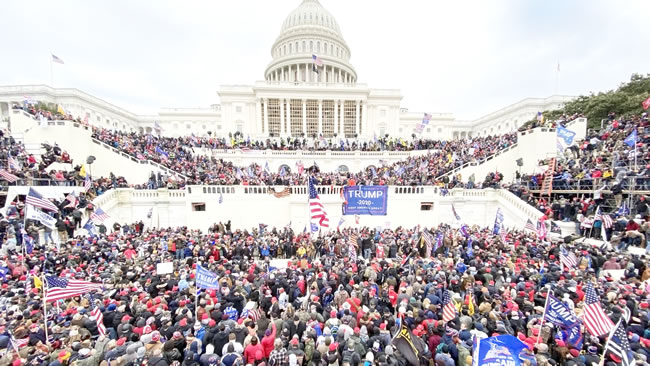A year ago, the United States of America’s Capitol, long ascribed as the global pictogram for democracy, lost its testimonial after a pro-Donald Trump mob attacked its occupants and sanctity, with the goal of disrupting the joint session of Congress assembled to count electoral votes that would formalise then President-elect Joe Biden’s victory. KEHINDE OYETIMI recalls the sad event, its aftermath, the legal and sociopolitical implications.
On January 6, 2021, a maddened horde seeking to overturn the impending electoral defeat of incumbent President Donald Trump attacked the United States Capitol in Washington, D.C. Their goal was to disrupt the joint session of Congress assembled to count electoral votes that would formalise then President-elect Joe Biden’s victory. Things began to happen in a disquieting rapidity. With the mob surging to inflict its wreckage, the Capitol Complex was locked down, thereby leading to the evacuation of lawmakers and staff. Law enforcement officers were the first to be attacked by the rioters; properties were destroyed, while they occupied the building for several hours. Reports had it that five people died shortly before, during, or following the event: one was shot by Capitol Police, another died of a drug overdose, and three died of natural causes. Many people were injured, including 138 police officers.
Historians have argued that while there had been other instances of violence at the Capitol in the 19th and 20th centuries, the 2021 event was the most severe assault on the building since the 1814 burning of Washington by the British Army during the War of 1812. U.C. Davis, a Law professor and scholar of legal history Carlton F.W. Larson informed that the framers of the U.S. constitution would have denounced the event as a treasonous act.
How it began
Starting at noon on January 6, at a rally, President Trump repeated claims of election irregularities and said, “If you don’t fight like hell, you’re not going to have a country any more”. During and after his speech, thousands of attendees walked to the Capitol and hundreds breached police perimeters as Congress was beginning the electoral vote count. Gallows had been erected west of the Capitol and some rioters chanted “Hang Mike Pence” after he rejected false claims by Trump and others that the vice president could overturn the election results. Some vandalized and looted the offices of House Speaker Nancy Pelosi and other members of Congress. Rioters occupied the empty Senate chamber while federal law enforcement officers defended the evacuated House floor. Pipe bombs were found at each of the Democratic National Committee and Republican National Committee headquarters, and Molotov cocktails were discovered in a vehicle near the Capitol.
Trump resisted sending the National Guard to quell the mob. Later that afternoon, in a Twitter video, he reasserted that the election was “fraudulent”, but told his supporters to “go home in peace”. The Capitol was clear of rioters by mid-evening, and the counting of the electoral votes resumed and completed in the early morning hours of January 7. Pence declared President-elect Biden and Vice-President-elect Kamala Harris victorious. Pressured by his administration, the threat of removal, and many resignations, Trump later committed to an orderly transition of power in a televised statement.
A week after the riot, the House of Representatives impeached Trump for incitement of insurrection, making him the only U.S. president to have been impeached twice. In February, after Trump had left office, the Senate voted 57–43 in favor of conviction; because this fell short of a two-thirds majority, requiring 67 votes, he was acquitted for a second time. The House passed a bill to create a bipartisan independent commission to investigate the attack, modeled after the 9/11 Commission, but it was blocked by Republicans in the Senate, so the House approved select committee with seven Democrats and two Republicans to investigate instead.
Dozens of people present in Washington, D.C. on the day, including some who took part in the riot, were found to be listed in the FBI’s Terrorist Screening Database, most as suspected white supremacists. Over 30 members of anti-government groups, including the Oath Keepers, Proud Boys, and Three Percenters, were charged with conspiracy for allegedly planning their attacks on the Capitol, but the majority of the people charged with crimes relating to the riot had no known affiliation with far-right groups.
How the violence had been predicted
In 2019, Kara Swisher, a columnist for The New York Times, envisioned what would happen “if Mr. Trump loses the 2020 election and tweets inaccurately the next day that there had been widespread fraud and, moreover, that people should rise up in armed insurrection to keep him in office”. Also, in early September 2020, citizen journalist Tim Pool said in a recorded conversation that “I’ve had messages from people saying that they’ve already got plans to rush to D.C. as soon as Nov. 3 goes chaotic”, and that, “The right-wing militias, the Oath Keepers, the Three Percenters, and just the Proud Boys and Trump supporters, they are going to rush full-speed to D.C. They are going to take the White House and do whatever they can and paramilitary”. On December 1, 2020, a Georgia election official publicly warned, “Stop inspiring people to commit potential acts of violence. Someone’s going to get hurt. Someone’s going to get shot. Someone’s going to get killed”.
On December 21, 2020, a viral tweet predicted “On January 6, armed Trumpist militias will be rallying in D.C., at Trump’s orders. On December 30, 2020, former Pence aide Olivia Troye publicly expressed fears “that violence could erupt in Washington, D.C., on January 6”.
Also, several organisations monitoring online extremism had been issuing warnings about the event. In an internal report dated December 29, 2020, the Federal Bureau of Investigation’s (FBI) Minneapolis field office warned of armed protests at every state capitol, orchestrated by the far-right movement, before Biden’s inauguration. Prior to January 6, 2021, the FBI notified the local Joint Terrorism Task Force of possible impending violence at the Capitol. The Washington Post reported an internal FBI document on January 5 warned of rioters preparing to travel to Washington and setting up staging areas in various regional states.
Reports also established that three days before the Capitol attack, the Capitol Police intelligence unit had circulated an internal memo warning that Trump supporters “see January 6, 2021, as the last opportunity to overturn the results of the presidential election” and could use violence against “Congress itself” on that date. U.S. Secretary of the Army Ryan D. McCarthy said law enforcement agencies’ estimates of the potential size of the crowd, calculated in advance of the event, varied between 2,000 and 80,000. On January 5, the National Park Service estimated that thirty thousand people would attend the “Save America” rally, based on people already in the area. Sadly, despite all of these predictions, the attack was not averted..
Aftermath
In the days following the attack on the Capitol, Republican politicians in at least three states introduced legislation creating new prohibitions on protest activity. After drawing widespread condemnation from Congress, members of his administration, and the media, Trump released a video-taped statement on January 7 to stop the resignations of his staff and the threats of impeachment or removal from office. In the statement, he condemned the violence at the Capitol, saying that “a new administration will be inaugurated”, which was widely seen as a concession, and his “focus now turns to ensuring a smooth, orderly, and seamless transition of power” to the Biden administration. White House press secretary Kayleigh McEnany had attempted to distance the administration from the rioters’ behavior in a televised statement earlier in the day. On January 9, The New York Times reported that Trump had told White House aides he regretted committing to an orderly transition of power and would never resign from office. In a March 25, 2021 interview on Fox News, Trump defended the Capitol attackers, saying they were patriots who posed “zero threat”, and he criticised law enforcement for “persecuting” the rioters.
More than seventy countries and international organizations expressed their concerns over the attack and condemned the violence, with some specifically condemning President Donald Trump’s own role in inciting the attack. Foreign leaders, diplomats, politicians, and institutions expressed shock, outrage, and condemnation of the events. Multiple world leaders made a call for peace, describing the riots as “an attack on democracy”.
The leaders of some countries, including Brazil, Poland and Hungary, declined to condemn the situation, and described it as an internal U.S. affair. Several NATO intelligence agencies outside the United States also briefed their governments that it was an attempted coup by President Trump which may have had help from federal law-enforcement officials.
The legal, sociopolitical repercussions
Obviously, the attack was followed by various political, legal, and social repercussions. The second impeachment of Donald Trump, who was charged for incitement of insurrection for his conduct, occurred on January 13. At the same time, Cabinet officials were pressured to invoke the 25th Amendment for removing Trump from office. Trump was subsequently acquitted in the Senate trial, which was held in February after Trump had already left office. The result was a 57–43 vote in favor of conviction, with every Democrat and seven Republicans voting to convict, but two-thirds of the Senate (67 votes) would have been required to convict.
Many in the Trump administration resigned. Several large companies announced they were halting all political donations, and others suspended funding the lawmakers who had objected to certifying Electoral College results. A bill was introduced to form an independent commission, similar to the 9/11 Commission, to investigate the events surrounding the attack; it passed the House but was blocked by Republicans in the Senate. The House then approved a House “select committee” to investigate the attack. In June, 2021, the Senate released the results of its own investigation of the riot. The event led to strong criticism of law enforcement agencies. Leading figures within the United States Capitol Police resigned.
A large-scale criminal investigation was undertaken, with the FBI opening more than 400 case files. Federal law enforcement undertook a nationwide manhunt for the perpetrators, with arrests and indictments following within days. More than 615 people have been charged with federal crimes. Per his involvement in inciting the storming of the Capitol, Trump was suspended from various social media sites, at first temporarily and then indefinitely. In response to various posts by Trump supporters in favor of the attempts to overturn the election, the social networking site Parler was shut down by its service providers. Corporate suspensions of other accounts and programs associated with participating groups also took place.
The inauguration week was marked by nationwide security concerns. Unprecedented security preparations for the inauguration of Joe Biden were undertaken, including the deployment of 25,000 National Guard members. In May, 2021, the House passed a $1.9 billion Capitol security bill in response to the attack.
With a year gone by, issues surrounding the attack have continued to be raised. University of Northern Colorado Professor of History Fritz Fischer, Ph.D., offers context from a historical perspective. “The riot itself wasn’t the most shocking thing; the most shocking thing was that it was our own president who directed an attack on our Congress, and that has no precedent in U.S. history and surprisingly few in world history,” he said. “To have one part of our government attack another part of the government is totally insane, and it was dangerous and antithetical to any traditional understanding of how our government should work.” Sadly, it’s one year and many Americans believe their cherished democracy is under threat.
YOU SHOULD NOT MISS THESE HEADLINES FROM NIGERIAN TRIBUNE
We Have Not Had Water Supply In Months ― Abeokuta Residents
In spite of the huge investment in the water sector by the government and international organisations, water scarcity has grown to become a perennial nightmare for residents of Abeokuta, the Ogun State capital. This report x-rays the lives and experiences of residents in getting clean, potable and affordable water amidst the surge of COVID-19 cases in the state…
Selfies, video calls and Chinese documentaries: The things you’ll meet onboard Lagos-Ibadan train
The Lagos-Ibadan railway was inaugurated recently for a full paid operation by the Nigerian Railway Corporation after about a year of free test-run. Our reporter joined the train to and fro Lagos from Ibadan and tells his experience in this report…
[ICYMI] Lekki Shootings: Why We Lied About Our Presence — General Taiwo
The Lagos State Judicial Panel of Inquiry probing the killings at Lekki Toll Gate, on Saturday resumed viewing of the 24hrs footage of the October 20, 2020 shooting of #EndSARS protesters by personnel of the Nigerian Army…
ICYMI: How We Carried Out The 1993 Nigerian Airways Hijack —Ogunderu
On Monday, October 25, 1993, in the heat of June 12 annulment agitations, four Nigerian youngsters, Richard Ajibola Ogunderu, Kabir Adenuga, Benneth Oluwadaisi and Kenny Razak-Lawal, did the unthinkable! They hijacked an Abuja-bound aircraft, the Nigerian Airways airbus A310, and diverted it to Niger Republic. How did they so it? Excerpts…
Sahabi Danladi Mahuta, a community mobiliser and APC chieftain. Mahuta spoke to select journalists at the sidelines of an Islamic conference in Abuja recently. Excerpts…






